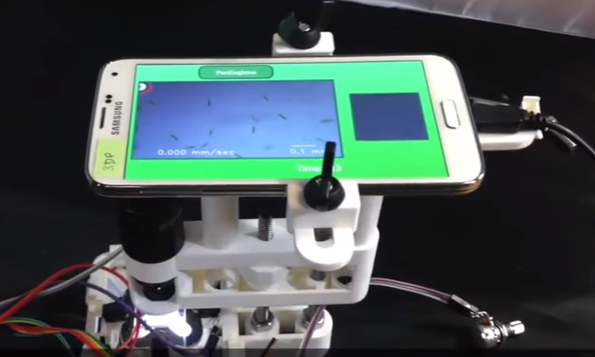A novel 3-dimensional printed, assembled smartphone microscope prepared at Stanford University transforms microbiology into a game of fire. This amazing device allows small kids to play games and even conduct serious observations with small light-seeking microbes known as Euglena.

“Numerous subject areas such as programming or engineering have selected toys that attract kids towards them, but microbiology does not offer that to the same degree,” says Riedel – Kruse, an assistant lecturer of bioengineering. “The core idea of this project was to play games with live cells on the phone. And then it developed into something beyond that and enables self-driven injury analysis and creating your own instrument.”
The device has been named as LudusScope by Riedel Kruse after the Latin word ‘Ludus,’ which implies play or game or elementary play school. Kruse along with his team member Honesty Kim are all set with their new development.
The LudusScope comprises a platform for the microscope slide where the Euglena moves freely, encompassed by four LEDs. Children can regulate the swimming direction of such light-responsive microbes with a joystick that triggers the LEDs. Children can operate a range of software on the phone that overlay on top of the cell’s image. One seems it like a 1980s famous video game Pac-man, comprising a maze containing small white dots. Kids can choose one cell to track and then employ LED lights to regulate the direction of swimming cells in an effort to guide it around the maze and capture the dots.
Besides this, it offers microscope scale-bars, virtual displays of swimming speed and even zoomed views of each cell. With this, kids can collect data on the behavior of Euglena, natural biological differences, and swimming speed. Each single element ranging from the chamber to the plastic microscope is something that the youngsters can prepare themselves from easily available parts and simple methods.
The project started as an element of Stanford bioengineering class taught by Riedel Kruse, with more intricate elements in it. But he himself wondered when saw that the elements can be simplified to great extent for learners. “We wondered if could create it so simple to replicate that even middle school learners could create it,” he says. The act of observing, modeling and building the cells fits easily within the novel science learning guidelines focused by the Next Generation Standards.
High school students and teachers who had an opportunity to interact with LudusScope saw a potential for education, although Riedel Kruse confirms that they valued the aspect of the game less than other features of the device. “I considered the interactive cell augmentation and the resulting game was the finest thing but the students and teachers did not agree to it,” says Riedel Kruse. “They were rather more excited about is the basic things such as the ability to create your own device or ability to control and track individual cells.”
Riedel Kruse is continuing to include latest updates in the LudusScope with input from students and teachers. He has already received a seed grant to associate with an educational game organization to introduce more user studies and to develop an entire science kit.
Filed Under: News


Questions related to this article?
👉Ask and discuss on Electro-Tech-Online.com and EDAboard.com forums.
Tell Us What You Think!!
You must be logged in to post a comment.